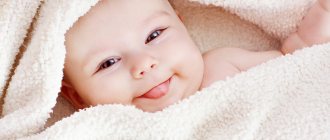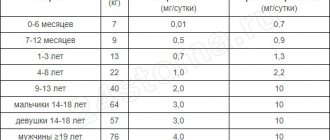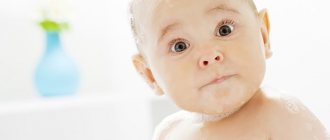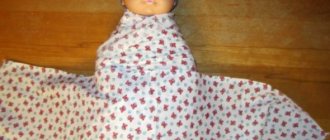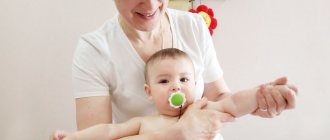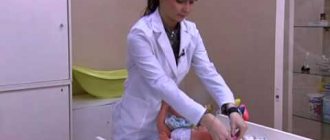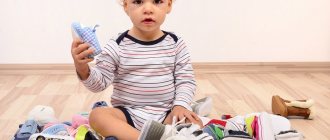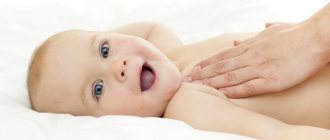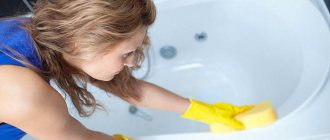February 22, 2017
Averyanova Sveta
There are no small details in caring for a small child. Knowing how to clean a newborn's ears is important for every mother. Good hearing and normal development of the baby depend on the health of children's ears.
A child's ears are a delicate organ that requires delicate handling, so it is important to clean them correctly. It is interesting to know the physiological characteristics and understand the processes occurring in the child’s body. The tips at the end of the article on the prevention of ear diseases in newborns will be useful.
Do I need to clean my baby's ears?
Of course, your baby’s ears need to be cleaned, but you still shouldn’t be too zealous. Such procedures must be completed in a timely manner. Cleaning out sulfur very often is not only not recommended, but also prohibited.
Of course, it looks terrible, but it performs useful functions:
- Sulfur helps keep the eardrum from drying out and moisturizes the ear canal.
- Protects the ear canal from various microbes.
That is why, if you are trying to completely clean out all the wax several times a day, you should know that a lack of earwax can lead to various infections. The second disadvantage of frequent ear cleaning is that wax begins to be released twice as fast.
Features of the structure of the auricle
The structure of a newborn's ears differs from that of an adult. This means that if you suddenly want to clean your ears with a cotton swab, you can do it, but under no circumstances should you pick your child’s ears with it.
This is due to the fact that at the beginning of a child’s life, his auricle is not yet fully formed - the eardrum is very close to the entrance and is not yet protected by cartilage. Because of this, making one wrong move can cause discomfort to the baby.
REFERENCE! A child's ears are a delicate part of the body that needs to be cleaned carefully and treated with special attention.
Earwax is a natural antiseptic produced in the auricle. It accumulates in the inner ear and appears outward only when there is a large amount. Only those excesses that are visible in the child’s outer ear need to be removed.
Wax is not dirt or a sign that a child is unkempt and unkempt. Therefore, you should take care of the newborn’s ears, do not clean them until they are perfectly clean, leaving a little wax in the canal. If there is no sulfur at all, then this will not lead to anything good.
Earwax:
- Moisturizes the ear canal and prevents the eardrum from drying out.
- Protects the inner ear from pathogens and other contaminants.
It is impossible to completely clean out sulfur, otherwise this can provoke even greater production.
If you clean too hard, pressing with cotton swabs, you can provoke complications that will subsequently bother the newborn.
What not to do
- A child's ears are so delicate that they can easily be damaged, which is why this procedure should be performed by a person whose nails are cut short.
- You cannot clean your baby's ears with a toothpick with cotton wool wrapped around it - you can damage the ear.
What is the best time to clean your ears?
Pediatricians advise cleaning your baby's ears after an evening bath or morning feeding. Moms will ask: “Why is this so?” After morning feeding, the baby begins to push out sulfur, which is why it will be very easy to remove. After an evening swim, droplets of water fall into the ears, the wax softens, and then it can be removed without damaging anything. You should also remember that children's ears do not like water inside, which is why it is necessary to remove it from the child's ears after each bath. If you do not do this, inflammation or otitis may occur, and you will have to consult a doctor.
Visit to a specialist
You should contact an otolaryngologist not only for routine checks, but also in the following cases:
- The sulfur does not come out of the ear canal. You should not remove it at home, as it can push even deeper, and it will be more difficult to get rid of it. The doctor will help remove wax quickly and painlessly.
- You should also contact a specialist if you notice an unpleasant odor coming from your baby’s ears.
- If there is discharge from your baby's ears, you should immediately consult a doctor.
- The sulfur has changed color and consistency. The shade of sulfur can range from yellow to dark brown. In the event that the color and consistency have changed dramatically, then it is necessary to urgently contact an otolaryngologist for help.
- Redness or inflammation of the ear.
- Foreign body in the ear canal.
Cleaning Recommendations
It is necessary to clean a baby's ears, but this should be done very carefully, in a special way, not in the same way as adults. How to clean your ears correctly?
- You only need to clean the part of the ear that is clearly visible. That is, the auricle. Penetrating deep into the ear can harm the child.
- It is necessary to clean only with specially designed sticks or rolled cotton pads.
- To clean your child's ears, place him on a flat surface and turn his head to the side.
- If you find a sulfur plug, then you should not try to remove it yourself, you need to contact a specialist.
There are few recommendations for cleaning the ears of babies, but they should definitely be used. If you ignore the advice, you can harm your child.
What do they clean with?
It is better to clean your baby’s ears with special cotton swabs with limiters. They look like regular ones, only with a thick cotton ball at the base, which prevents the stick from penetrating deeply into the ear canal.
Regular cotton swabs can only be used to wipe the auricle without penetrating into the ear. The ears are also wiped with cotton wool or cotton pads, without putting them inside.
You probably already understand why you need to do this. The ear is a self-cleaning organ, so only the outer part is wiped.
You cannot use matches with cotton wool or toothpicks for this hygienic procedure.
Rules for cleaning children's ears
- First, you need to place the baby on a flat surface and turn his head to the side.
- Then you should soak a cotton swab or swab in hydrogen peroxide or warm water. Under no circumstances should you wet the cotton wool too much.
- Next, you need to wipe the baby’s ear, without penetrating deeply.
- You should remember that if you notice accumulations in your baby’s ear canal, you should not clean it yourself; it is better to contact an otolaryngologist.
- Also, use a cotton pad slightly moistened in a weak solution of hydrogen peroxide to wipe behind the ear.
Children under one year old should clean their ears with caution. In order for everything to go well, you must strictly adhere to the above recommendations and rules.
How can you prevent ear diseases?
When you bathe your baby, you should be careful not to let water get into the ears. If, nevertheless, it penetrates there, you need to take a dry cotton swab and apply it to the external auditory canal - this will help dry it.
After feeding, you need to place the baby standing, because if this is not done, the baby will burp and the milk will fall into the Eustachian tube, which connects the ear to the nasopharynx.
In windy and cold weather, the baby should definitely wear a hat that covers the ears. The hat must be selected so that it is not too cold or too hot. The heat may cause prickly heat or diaper rash.
How to properly clean earwax from a newborn's ears
To remove sulfur formations in babies, it is recommended to use a cotton swab. It is permissible to use special children's chopsticks with a limiter. Before performing the manipulations, the tip must be well moistened with water so that when pressed, small droplets freely stand out.
In the area of the external ear canal, a moistened flagellum is carefully applied. When moving, do not apply pressure or force. If the cotton end becomes dirty, you need to replace the instrument and repeat the procedure until it is completely clean. It is enough to carry out this type of manipulation 1 or 2 times a week.
What not to do
Mistakes when carrying out the procedure for cleaning children's ears are fraught with complications. When performing sucking movements, sulfur formations come out on their own, so light movements are enough to remove them. The following actions should not be allowed:
- Insert cleaning tools into the ear canal;
- Use sticks and flagella generously moistened with dripping water;
- Make an effort and try to rub the ear area.
An attempt to clean the ear canal from the inside leads to the opposite effect and the wax goes deeper. As a result of such actions, the situation worsens, since a barrier is created to the natural cleansing of the baby's ear.
What else do you need to remember?
- How to clean your ears? The most popular options are a flagellum made from a cotton pad or an ordinary CHILDREN'S cotton swab with a limiter. This restriction prevents the stick from penetrating too deeply into the ear and protects it from injury. Important: a cotton bud can leave lint in the baby’s ear, which can not only cause discomfort, but also inflammation.
- At what age should I start? Cleaning the ears is a delicate process, and in the first weeks of a baby’s life such a procedure is unnecessary. You can start cleaning after 2 weeks, when the baby adapts to the outside world.
- What can't you clean? Any devices that are not intended for these purposes - from matches and toothpicks to ordinary cotton swabs. Also, you should not use oils, milk and other “improvised” means to lubricate the flagellum or stick.
- Permitted means. The list consists of only 1 item: hydrogen peroxide – exclusively fresh and not higher than 3%. True, babies don’t need it for regular ear cleaning either, and besides, it’s permissible to use the product no more than once a week.
- How often to clean? Starting from 2 weeks, your baby's ears can be cleaned once a week or a week and a half. The procedure includes cleansing the auricle and the area around the outside of the ear.
- When to clean? The ideal option is to bathe the baby, feed it and immediately start cleaning the ears. After bathing, the wax in the ears will soften, and as a result of sucking movements it will come out from the depths of the ear canal.
How to properly apply a compress to a child’s ear - instructions
Daily care rules
In addition to carrying out manipulations to remove wax formations, you must not forget to care for the baby’s outer ear. It is enough to wipe the ear curls with a cotton wool 1 or 2 times every 7 days. You need to pull the skin of the ear a little and work on the bends and folds.
During morning washing, it is necessary to wipe the areas located behind the baby's ear. This is done using a cotton ball, which is pre-moistened in boiled water. After completing the washing procedures and identifying the first signs of irritation, diaper rash or crusts, lubricate the affected area with petroleum jelly.
What to do to prevent ear disease
Following simple rules for caring for your baby will avoid complications and will guarantee the child’s well-being. The following recommendations should be followed:
- When bathing, do not allow water to get into the ear; if liquid has penetrated into the passage, then it is necessary to remove excess moisture using a cotton wool flagellum;
- Upon completion of feeding, ensure a “column” position, which will help prevent milk from getting into the Eustachian tube when regurgitating;
- When walking, wear a hat, making sure it covers your ears;
- Select clothing according to weather conditions to prevent prickly heat and diaper rash behind the ears.
Compliance with simple rules and preventive measures for the baby’s ears will guarantee his good health and relieve parents from worries about his health.
When a child is born, new parents face great responsibility, new responsibilities and certain difficulties. Bathing a child, properly treating an umbilical wound and cleaning a baby’s ears – such seemingly simple hygiene procedures make mothers and fathers very worried! Earwax accumulates in children's ears, just like in adults, and parents think about how to properly clean the ears of a newborn.
Caring for baby's ears: where do we clean and where not?
How to clean the delicate ears of an infant and, in general, does it make sense? This routine hygienic procedure requires certain skills and knowledge. It is imperative to clean your child’s ears, and this should be done not only from the inside, but also outside. If the area behind the ears is ignored during care, the child may develop discomfort, crusts, diaper rash, and even serious illnesses.
Crusts are formed due to gross non-compliance with hygiene rules. During the feeding process, breast milk drains and enters the folds behind the baby's ear, where it dries, subsequently forming crusts. They should never be removed dry, as this will cause severe pain to the baby. You can minimize the pain when removing crusts using a cotton pad slightly moistened with warm water.
In addition, crusts may indicate a childhood allergy. For example, their cause may be the use of low-quality shampoos for children or errors in the mother’s diet if the child is breastfed. Diaper rash occurs when a child's ears are not sufficiently dried after taking water treatments. The first thing you should do is not put on a cap after a bath, because the baby’s skin should breathe freely at least a little.
READ ALSO: Is it possible to remove plugs in a child’s ears at home?
Proper care technique
In order not to injure the baby, you should follow the technique and provide proper care for the ears of a newborn baby. It is recommended to carry out the procedure immediately after bathing. The baby needs to be laid on his side on a flat surface and calmed down. When removing wax, it is recommended to use baby cotton swabs that have a limiter. Immediately before the procedure, you need to wet the cotton swab, but so that when pressed, no water comes out of it.
The most important thing when performing basic hygiene procedures is not to cause harm, do everything carefully and accurately. The fact is that the auricle of a newborn differs significantly in structure from that of an adult. It is not fully formed, and therefore the eardrum is located very close to the entrance to the ear. Any incorrect, erroneous movement can cause pain and discomfort.
Auricle
When cleaning your ears, do not insert the stick deep inside the ear canal, use a wet ear stick, or roughly rub the skin. There is no need to worry about the cleanliness of the baby's inner ear; earwax comes out on its own when the baby makes sucking movements during feeding. By trying to clean the inside of the ear with a cotton swab, parents only aggravate the situation and push the wax even deeper, then the ear canal cannot clean itself.
Once a week, it is recommended to wipe the curls and shells of the ear with a moistened cotton pad. This is done by carefully pulling the ear to allow access to all folds and bends.
In the modern world, devices with a special limiter have been created for the little ones, allowing them to safely and effectively care for a baby’s ears (see the video below for how to do this). When treating the ears, lightly move the stick along the external auditory canal. Having cleaned one ear, proceed to the second. You need to repeat the procedure, changing cotton pads until the wax is completely removed. Doing this twice a week is enough to keep your child’s ears healthy and clean.
Children should not clean their ears with standard chopsticks that adults use. Experts do not recommend dripping hydrogen peroxide into the ear canal of an infant under one year of age as a means of removing wax.
After bathing, be sure to remove water from the auricle using a cotton pad, which must be placed in the ear and then blotted with light movements. There is no need to dry your ear with a hairdryer or use a heating pad if water gets in, because this not only will not save the situation, but can also worsen it. Older children's ears should also be cleaned carefully to avoid inflammation and skin irritation.
Behind the ears
Pediatricians also recommend that every morning, while washing your face, gently wipe the skin behind the ears with a cotton ball soaked in boiled water. If crusts, diaper rash or other irritations appear in a child, you can wipe the skin with Vaseline-based oil.
In some cases, excess wax builds up in the ear canal. The most common reasons for this are:
- Infectious diseases. If an infectious agent circulates in the baby's blood, this can cause inflammatory diseases and contribute to the frequent formation of sulfur plugs.
- Anomalies of the ear structure. Wax can accumulate in large quantities due to a newborn's curved ear canal and other congenital abnormalities.
- Cleaning your ears too often also leads to active wax production.
How to do it right
You can clean your baby's ears in the morning or evening. In the morning after feeding, and in the evening after daily bathing. Sulfur is intensively removed from the ear canal during swallowing movements.
Therefore, after feeding the baby and moving on to morning hygiene, you can start cleaning the ears.
Sequence of actions in the morning:
- take cotton swabs with a limiter or roll a small ball out of cotton wool;
- moisten the cotton wool with a little clean boiled water so that it is not wet, but slightly damp;
- Wipe the curves of the auricle, the area behind the ears and the ear curl with a cotton swab or stick.
After bathing, water may get into your baby's ears. This is not scary, but you need to blot it dry so that inflammation does not start. To do this, place a cotton ball in each ear. Turn the baby over on one side, then on the other. Cotton wool will quickly absorb moisture that gets into the ear canal. You need to take the wet cotton wool out of the baby’s ears and wipe the ears with dry cotton wool.
Please note that you must use a separate stick or cotton wool for each ear. To prevent infection in case of illness.
Some mothers heard advice from their parents to soak a cotton swab in oil. Is it really possible to do this? Experts say that oil flowing down the ear canal can cause wax to swell and make it difficult to remove it from the ear. Therefore, although it is indeed convenient to use oil to remove wax from the ear, it is better not to do it. If wax plugs form and the ear canal becomes blocked, you will have to visit an otolaryngologist to get professional help.
Do you need to clean your ears? Opinion of B. Spock and E. O. Komarovsky
Dr. Komarovsky, like Benjamin Spock, recommends not cleaning a newborn’s ears unnecessarily, especially since doctors are against deep cleaning, which can harm him. Deep cleansing of the ear canal is impractical, because the wax moves on its own, cleaning the ear. This happens because there are microvilli in the external auditory canal that constantly vibrate and move wax accumulations towards the exit.
A baby's ear has very delicate cartilage, the ear canal is much shorter than that of an adult, and the wax has a more liquid consistency. When performing hygienic manipulations, it is forbidden to pull too much on the auricle; even this can tear the delicate tissues and deform them.
Benjamin Spock believes that too frequent irrigation and mechanical cleaning can lead to otitis externa. If your baby has a wax plug, under no circumstances should you remove it yourself. In such cases, you should immediately consult a doctor; he will remove the plug without injuring the child’s ear.
If the baby is coughing, it is better to postpone the ear cleaning procedure until the child has recovered and the cough has completely passed. A baby crying after each cleaning indicates that the parent is being too rude and aggressive in the procedure.
Causes of sulfur formation in an infant
The main function of earwax is to protect the ear canal. It contains various substances, including fats, that protect the eardrum from all kinds of damage. Due to sulfur, an acidic environment is maintained in the ear cavity, which ensures the prevention of viral and bacterial infections.
Attention! The process of earwax formation occurs in any healthy person, including an infant. Normally, wax leaves the ear canal on its own, meaning no special cleaning is required.
In some cases, excess earwax forms in the cavity. The reason for this often lies in various diseases of the hearing organs and some anomalies:
- Diseases resulting from increased activity of pathogenic microorganisms. Thus, the body exhibits its own immune abilities. This process poses some danger - wax plugs may form in the baby.
- Pathologies of the structure of the hearing organ. Curvature of the ear canal can cause increased wax production. In this case, the exudate will have a liquid consistency and light color.
- Excessive ear canal hygiene. Violations of the rules of hygiene procedures can cause increased formation of wax in the baby’s ear.
If the formation process is activated for unknown reasons, the child must be shown to an otolaryngologist. A specialist will help establish the true cause and tell parents how to clean the ears of a newborn child correctly, because it is a violation of the algorithm of actions that often causes a failure of the natural process.
Why is sulfur needed?
Earwax is present in the depths of the ear for a reason. It performs the important functions of cleansing and protecting the ear canals from pathogenic bacteria and fungal infections. Earwax also provides lubrication and moisturization to the skin of the external auditory canal. Natural secretions help get rid of dead cells, dust and other impurities that settle in the ear canal. Earwax is released by human actions such as yawning and chewing movements.
Many people use cotton swabs to remove wax from the ear canal, and do this almost every day. This is a mistake because the result is the opposite. Due to constant irritation of the surface of the ear canal, the body begins to produce even more earwax, receiving a signal about its lack. As a result, hypersecretion develops, and there is more wax in the ears than before. In addition, it ceases to fully perform its functions: the ear canal is deprived of proper protection and is not sufficiently moistened. Often the inner ear is injured by a cotton swab. Therefore, you need to clean your ears, but not too often, using other devices rather than cotton swabs. This is especially true for infants.
The structure of a child's ear
The formation of the auricle of a newborn baby continues after birth. This means that the eardrum is too close to the entrance, and the cartilage does not close it, as it does in adults. The auditory canal of a small child is short and wide, without bends. There is no bone section. All these features make the baby's ear very vulnerable. Therefore, any penetration into the ear canal can be fraught not only with unpleasant sensations for your child, but also with serious damage. Therefore, the use of cotton swabs to clean children's ears is prohibited.
Why clean?
The wax used to clean the ears keeps them healthy. It suppresses the development of pathogenic bacteria that can get inside with water or air. Sulfur is also a kind of lubricating and moisturizing medium for the ear canals.
Nature has provided for excess sulfur to be eliminated independently. The outer ear canal is covered with small villi that push wax toward the auricle. This process occurs especially intensely during swallowing and yawning. Therefore, there is no need to remove wax from the depths of the ear.
In small quantities, sulfur is useful, but if it accumulates, it can itself become a source of infection and a habitat for pathogenic bacteria. When earwax gets on the skin, it causes irritation. Therefore, knowing how to properly clean your ears is important not only for ethical purposes, but also for maintaining health.
How, what and when to clean a baby’s ears
Before performing hygiene procedures, it is better to consult a doctor. It makes sense to clean your newborn's ears when you see excess wax on the surface of the ear. On average, ears can be cleaned once every 10 days. Most often, pediatric otolaryngologists recommend using cotton wool for these purposes.
So, how to clean your child’s ears:
- choose the evening, preferably after swimming. Usually, after water procedures, babies are calmer and more relaxed. The ears will be slightly moistened, the wax will soften, which will only contribute to effective cleansing;
- Even before bathing, roll the cotton wool into flagella;
- Place the baby on a changing table or on a bed or sofa. Turn the head to the side so that you can clearly see the baby’s ear (it is advisable to carry out the procedure in a well-lit room);
- Take a cotton swab and gently wipe the outer (visible) part of your ear. There is no need to go deep into the ear canal so as not to harm the child. Even if there is sulfur there, it does not need to be removed. We have already talked about the beneficial properties of this substance;
- Clean the second ear using the same procedure.
Don't forget about hygiene behind your ears. After each bath, this area must be wiped dry with gentle movements, like any other folds on the baby's body. To cleanse the skin behind the ears, use cotton pads folded in half. Gently blot the area behind the ears without applying too much pressure to your baby's skin.
If you choose a time for hygiene other than after bathing, you can use two types of cotton swabs and pads - dry and wet. First, wipe the outer part of the ear with a damp cotton swab and the fold behind the ear with a damp cotton pad. Please note that the cotton wool should be only slightly wet - no water should flow from it when pressed. After this, blot the baby's ears with a dry flagellum and disk. This way the cleansing will be maximum.
Please note that if the baby resists, is capricious, or simply not in the mood, then it is better to perform the procedure another time. Otherwise, you may cause harm with your actions, and the cleansing will not be complete. In addition, if you forcefully clean your ears, over time you will develop a dislike for this procedure.
Diaper rash and crusts behind the ears
If the area behind the ears is cleaned incorrectly and untimely, crusts and diaper rash may form there. Some parents are not very attentive to the child during feeding. But milk often flows down the baby’s cheeks, heading straight into the fold behind the ear. There it dries and turns into a crust. This brings a lot of unpleasant sensations to the child - he may be capricious, cry, worry. Therefore, regularly check how clean your child’s ears are. If you notice such a crust, then under no circumstances remove it dry. First, moisten it with warm boiled water and let it soak. Then carefully remove using a cotton pad or ball.
As for diaper rash, this problem occurs when the skin is not completely dry. Perhaps the parents, without allowing the hair to dry completely, put a cap or cap on the baby. As a result, a wet hat will cause diaper rash in the baby. Another factor that causes diaper rash may be over-wrapping the baby, which can lead to prickly heat. Therefore, do not overdo it when taking care of your child - keep it in moderation. Watch your baby - if he is hot, undress him, if he is cold, dress him. Do not impose your own ideas on the little person about what is good for him and what is bad. The baby's body is no more stupid than its parents.
What not to do when cleaning your ears
In order not to harm your own child, remember a few taboos when cleaning a baby’s ears:
- use cotton swabs or toothpicks/matches with cotton wool wrapped around them;
- use different oils when cleaning your ears;
- start cleaning your baby’s ears if you have long nails;
- try to independently remove wax plug or any foreign object. In this case, you should immediately visit an otolaryngologist.
Should a baby have wax removed?
The ears of an infant are the same part of the body that requires certain care, so keeping them clean is necessary, first of all, to maintain hearing health and hygiene. Not all mothers know how to properly clean a newborn’s ears, and therefore, due to inexperience, they can harm the baby.
Attention! Normally, a small amount of wax accumulates in the ear canal. In this case, the composition maintains optimal balance and protects the middle ear from various microtraumas. While excessive volumes can become the basis for the successful proliferation of pathogenic microorganisms and cause the development of diseases and inflammatory processes.
It must be taken into account that the eardrum is located at a close distance from the entrance, so the cleaning process should be carried out extremely carefully. You need to pay attention to the fact that completely removing wax and cleaning your ears every day is prohibited; excessive scrupulousness in this matter will do more harm than good. Pediatric otolaryngologists and pediatricians recommend performing the procedure once every 7–10 days. The cleaning process should be carried out after an evening swim, before going to bed.
